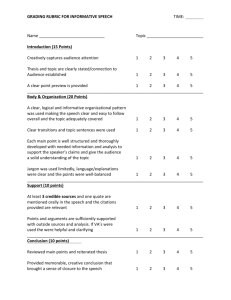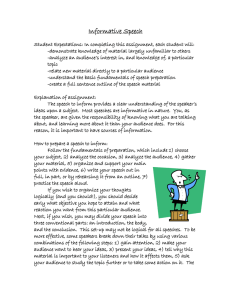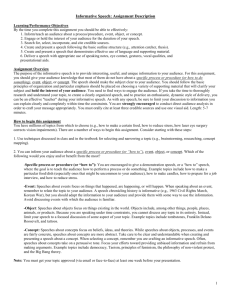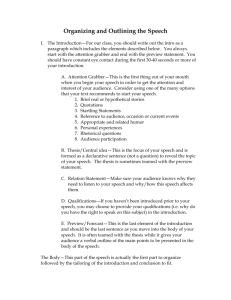Informative Speaking Guide
advertisement
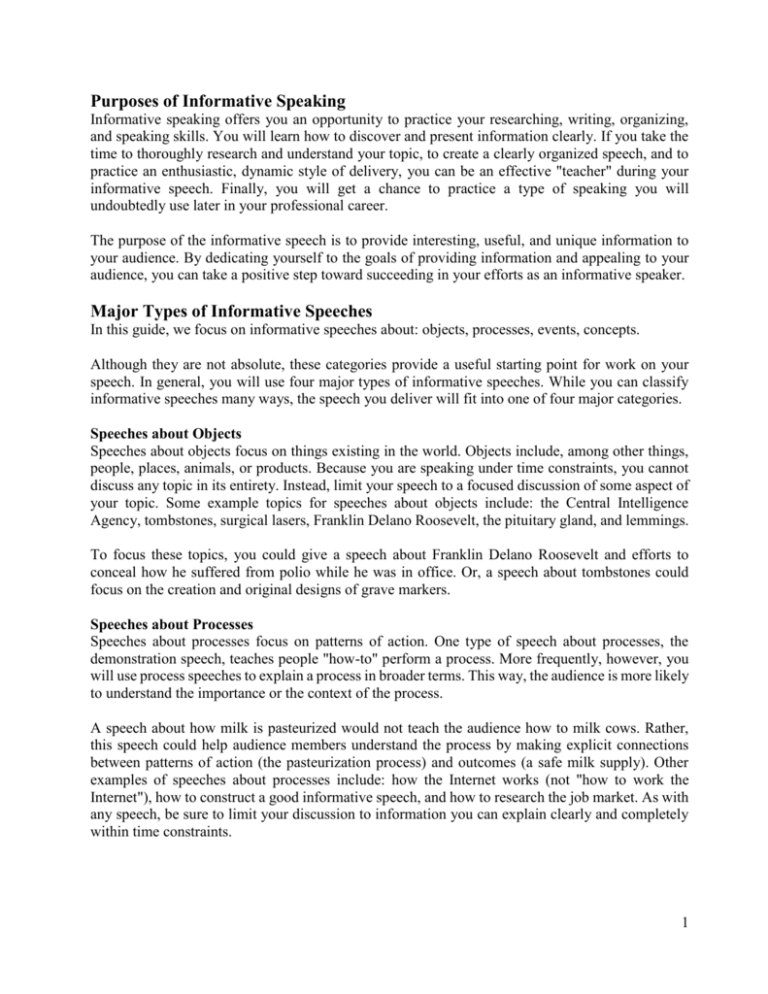
Purposes of Informative Speaking Informative speaking offers you an opportunity to practice your researching, writing, organizing, and speaking skills. You will learn how to discover and present information clearly. If you take the time to thoroughly research and understand your topic, to create a clearly organized speech, and to practice an enthusiastic, dynamic style of delivery, you can be an effective "teacher" during your informative speech. Finally, you will get a chance to practice a type of speaking you will undoubtedly use later in your professional career. The purpose of the informative speech is to provide interesting, useful, and unique information to your audience. By dedicating yourself to the goals of providing information and appealing to your audience, you can take a positive step toward succeeding in your efforts as an informative speaker. Major Types of Informative Speeches In this guide, we focus on informative speeches about: objects, processes, events, concepts. Although they are not absolute, these categories provide a useful starting point for work on your speech. In general, you will use four major types of informative speeches. While you can classify informative speeches many ways, the speech you deliver will fit into one of four major categories. Speeches about Objects Speeches about objects focus on things existing in the world. Objects include, among other things, people, places, animals, or products. Because you are speaking under time constraints, you cannot discuss any topic in its entirety. Instead, limit your speech to a focused discussion of some aspect of your topic. Some example topics for speeches about objects include: the Central Intelligence Agency, tombstones, surgical lasers, Franklin Delano Roosevelt, the pituitary gland, and lemmings. To focus these topics, you could give a speech about Franklin Delano Roosevelt and efforts to conceal how he suffered from polio while he was in office. Or, a speech about tombstones could focus on the creation and original designs of grave markers. Speeches about Processes Speeches about processes focus on patterns of action. One type of speech about processes, the demonstration speech, teaches people "how-to" perform a process. More frequently, however, you will use process speeches to explain a process in broader terms. This way, the audience is more likely to understand the importance or the context of the process. A speech about how milk is pasteurized would not teach the audience how to milk cows. Rather, this speech could help audience members understand the process by making explicit connections between patterns of action (the pasteurization process) and outcomes (a safe milk supply). Other examples of speeches about processes include: how the Internet works (not "how to work the Internet"), how to construct a good informative speech, and how to research the job market. As with any speech, be sure to limit your discussion to information you can explain clearly and completely within time constraints. 1 Speeches about Events Speeches about events focus on things that happened, are happening, or will happen. When speaking about an event, remember to relate the topic to your audience. A speech chronicling history is informative, but you should adapt the information to your audience and provide them with some way to use the information. As always, limit your focus to those aspects of an event that can be adequately discussed within the time limitations of your assignment. Examples of speeches about events include: the 1963 Civil Rights March on Washington, Groundhog's Day, The Battle of the Bulge, the World Series, and the 2008 Presidential Elections. Speeches about Concepts Speeches about concepts focus on beliefs, ideas, and theories. While speeches about objects, processes, and events are fairly concrete, speeches about concepts are more abstract. Take care to be clear and understandable when creating and presenting a speech about a concept. When selecting a concept, remember you are crafting an informative speech. Often, speeches about concepts take on a persuasive tone. Focus your efforts toward providing unbiased information and refrain from making arguments. Because concepts can be vague and involved, limit your speech to aspects that can be readily explained and understood within the time limits. Some examples of topics for concept speeches include: democracy, Taoism, principles of feminism, the philosophy of non-violent protest, and the Big Bang theory. Strategies for Selecting a Topic In many cases, circumstances will dictate the topic of your speech. However, if the topic has not been assigned or if you are having difficulty figuring out how to frame your topic as an informative speech. The following may be useful. Begin by thinking of your interests. If you have always loved art, contemplate possible topics dealing with famous artists, art works, or different types of art. If you are employed, think of aspects of your job or aspects of your employer's business that would be interesting to talk about. While you cannot substitute personal experience for detailed research, your own experience can supplement your research and add vitality to your presentation. Choose one of the items below to learn more about selecting a topic. Learn More about an Unfamiliar Topic. You may benefit more by selecting an unfamiliar topic that interests you. You can challenge yourself by choosing a topic you'd like to learn about and to help others understand it. If the Buddhist religion has always been an interesting and mysterious topic to you, research the topic and create a speech that offers an understandable introduction to the religion. Remember to adapt Buddhism to your audience and tell them why you think this information is useful to them. By taking this approach, you can learn something new and learn how to synthesize new information for your audience. Think about Previous Classes. You might find a topic by thinking of classes you have taken. Think back to concepts covered in those classes and consider whether they would serve as unique, interesting, and enlightening topics for the informative speech. In astronomy, you learned about red giants. In history, you learned about Napoleon. In political science, you learned about The Federalist Papers. Past classes serve as rich resources for informative speech topics. If you make this choice, use your class notes and textbook as a starting point. To fully develop the content, you will need to do extensive research and perhaps even a few interviews. 2 Talk to Others. Topic selection does not have to be an individual effort. Spend time talking about potential topics with classmates or friends. This method can be extremely effective because other people can stimulate further ideas when you get stuck. When you use this method, always keep the basic requirements and the audience in mind. Just because you and your friend think home-brew is a great topic does not mean it will enthrall your audience or impress your instructor. While you talk with your classmates or friends, jot notes about potential topics and create a master list when you exhaust the possibilities. From this list, choose a topic with intellectual merit, originality, and potential to entertain while informing. Framing a Thesis Statement Once you settle on a topic, you need to frame a thesis statement. Framing a thesis statement allows you to narrow your topic, and in turns allows you to focus your research in this specific area, saving you time and trouble in the process. Selecting a topic and focusing it into a thesis statement can be a difficult process. Fortunately, a number of useful strategies are available to you. Thesis Statement Purpose The thesis statement is crucial for clearly communicating your topic and purpose to the audience. Be sure to make the statement clear, concise, and easy to remember. Deliver it to the audience and use verbal and nonverbal illustrations to make it stand out. Strategies for Framing a Thesis Statement Focus on a specific aspect of your topic and phrase the thesis statement in one clear, concise, complete sentence, focusing on the audience. This sentence sets a goal for the speech. For example, in a speech about art, the thesis statement might be: "The purpose of this speech is to inform my audience about the early works of Vincent van Gogh." This statement establishes that the speech will inform the audience about the early works of one great artist. The thesis statement is worded conversationally and included in the delivery of the speech. Thesis Statement and Audience The thesis appears in the introduction of the speech so that the audience immediately realizes the speaker's topic and goal. Whatever the topic may be, you should attempt to create a clear, focused thesis statement that stands out and could be repeated by every member of your audience. It is important to refer to the audience in the thesis statement; when you look back at the thesis for direction, or when the audience hears the thesis, it should be clear that the most important goal of your speech is to inform the audience about your topic. While the focus and pressure will be on you as a speaker, you should always remember that the audience is the reason for presenting a public speech. Avoid being too trivial or basic for the average audience member. At the same time, avoid being too technical for the average audience member. Be sure to use specific, concrete terms that clearly establish the focus of your speech. 3 Thesis Statement and Delivery When creating the thesis statement, be sure to use a full sentence and frame that sentence as a statement, not as a question. The full sentence, "The purpose of this speech is to inform my audience about the early works of Vincent van Gogh," provides clear direction for the speech, whereas the fragment "van Gogh" says very little about the purpose of the speech. Similarly, the question "Who was Vincent van Gogh?" does not adequately indicate the direction the speech will take or what the speaker hopes to accomplish. If you limit your thesis statement to one distinct aspect of the larger topic, you are more likely to be understood and to meet the time constraints. Researching Your Topic As you begin to work on your informative speech, you will find that you need to gather additional information. Your instructor will most likely require that you locate relevant materials in the library and cite those materials in your speech. In this section, we discuss the process of researching your topic and thesis. Conducting research for a major informative speech can be a daunting task. In this section, we discuss a number of strategies and techniques that you can use to gather and organize source materials for your speech. Gathering Materials Gathering materials can be a daunting task. You may want to do some research before you choose a topic. Once you have a topic, you have many options for finding information. You can conduct interviews, write or call for information from a clearinghouse or public relations office, and consult books, magazines, journals, newspapers, television and radio programs, and government documents. The library will probably be your primary source of information. You can use many of the libraries databases or talk to a reference librarian to learn how to conduct efficient research. Some Cautions When doing research, use caution in choosing your sources. You need to determine which sources are more credible than others and attempt to use a wide variety of materials. The broader the scope of your research, the more impressive and believable your information. You should draw from different sources as well as different types of sources (i.e., use interviews, newspapers, periodicals, and books instead of just newspapers). The greater your variety, the more apparent your hard work and effort will be. Solid research skills result in increased credibility and effectiveness for the speaker. Structuring an Informative Speech Typically, informative speeches have three parts: 1. Introduction 2. Body 3. Conclusion In this section, we discuss the three parts of an informative speech, calling attention to specific elements that can enhance the effectiveness of your speech. As a speaker, you will want to create a clear structure for your speech. In this section, you will find discussions of the major parts of the informative speech. 4 Introduction The introduction sets the tone of the entire speech. The introduction should be brief and to-the-point as it accomplishes these several important tasks. Typically, there are six main components of an effective introduction: 1. Attention Getters 2. Thesis Statement 3. Audience Adaptation 4. Credibility Statement 5. Preview 6. Transition to the Body As in any social situation, your audience makes strong assumptions about you during the first eight or ten seconds of your speech. For this reason, you need to start solidly and launch the topic clearly. Focus your efforts on completing these tasks and moving on to the real information (the body) of the speech. Typically, there are six main components of an effective introduction. These tasks do not have to be handled in this order, but this layout often yields the best results. Attention Getters The attention-getter is designed to intrigue the audience members and to motivate them to listen attentively for the next several minutes. There are infinite possibilities for attention-getting devices. Some of the more common devices include using a story, a rhetorical question, or a quotation. While any of these devices can be effective, it is important for you to spend time strategizing, creating, and practicing the attention-getter. Most importantly, an attention-getter should create curiosity in the minds of your listeners and convince them that the speech will be interesting and useful. The wording of your attention-getter should be refined and practiced. Be sure to consider the mood/tone of your speech; determine the appropriateness of humor, emotion, aggressiveness, etc. Not only should the words get the audience’s attention, but your delivery should be smooth and confident to let the audience know that you are a skilled speaker who is prepared for this speech. A Story The crowd was wild. The music was booming. The sun was shining. The cash registers were ringing. This story-like re-creation of the scene at a Farm Aid concert serves to engage the audience and causes them to think about the situation you are describing. Touching stories or stories that make audience members feel involved with the topic serve as good attention-getters. Rhetorical Question Rhetorical questions are questions designed to arouse curiosity without requiring an answer. Either the answer will be obvious, or if it isn't apparent, the question will arouse curiosity until the presentation provides the answer. An example of a rhetorical question to gain the audience’s attention for a speech about fly-fishing is, "Have you ever stood in a freezing river at 5 o'clock in the morning by choice?" Quotation A quotation from a famous person or from an expert on your topic can gain the attention of the audience. The use of a quotation immediately launches you into the speech and focuses the audience 5 on your topic area. If it is from a well-known source, cite the author first. If the source is obscure, begin with the quote itself. Unusual Statement Making a statement that is unusual to the ears of your listeners is another possibility for gaining their attention. Humor You might chose to use tasteful humor which relates to the topic as an effective way to attract the audience both to you and the subject at hand. Shocking Statistic Another possibility to consider is the use of a factual statistic intended to grab your listener's attention. As you research the topic you've picked, keep your eyes open for statistics that will have impact. Thesis Statement The thesis statement is crucial for clearly communicating your topic and purpose to the audience. Be sure to make the statement clear, concise, and easy to remember. Deliver it to the audience and use verbal and nonverbal illustrations to make it stand out. Audience Adaptation In your introduction, you need to adapt your speech to your audience. To keep audience members interested, tell them why your topic is important to them. To accomplish this task, you need to undertake audience analysis prior to creating the speech. Figure out who your audience members are, what things are important to them, what their biases may be, and what types of subjects/issues appeal to them. In the context of this class, some of your audience analysis is provided for you-most of your listeners are college students, so it is likely that they place some value on education, most of them are probably not bathing in money, and they live in Colorado. Consider these traits when you determine how to adapt to your audience. As you research and write your speech, take note of references to issues that should be important to your audience. Include statements about aspects of your speech that you think will be of special interest to the audience in the introduction. By accomplishing this task, you give your listeners specific things with which they can identify. Audience adaptation will be included throughout the speech, but an effective introduction requires meaningful adaptation of the topic to the audience. You need to find ways to get the members of your audience involved early in the speech. The following are some possible options to connect your speech to your audience: Reference to the Occasion Reference to the Previous Speaker Credibility Statement The credibility statement establishes your qualifications as a speaker. You should come up with reasons why you are someone to listen to on this topic. Why do you have special knowledge or understanding of this topic? What can the audience learn from you that they couldn't learn from someone else? Credibility statements can refer to your extensive research on a topic, your life-long interest in an issue, your personal experience with a thing, or your 6 desire to better the lives of your listeners by sifting through the topic and providing the crucial information. Good Will Your listeners want to believe that you have their best interests in mind. In the case of an informative speech, it is enough to assure them that this will be an interesting speech and that you, yourself, are enthusiastic about the topic. Preview the Main Points The preview informs the audience about the speech's main points. You should preview every main body point and identify each as a separate piece of the body. The purpose of this preview is to let the audience members prepare themselves for the flow of the speech; therefore, you should word the preview clearly and concisely. Attempt to use parallel structure for each part of the preview and avoid delving into the main point; simply tell the audience what the main point will be about in general. Use the preview to briefly establish your structure and then move on. Let the audience know how you will divide the topic and fulfill the thesis and then move on. This important tool will reinforce the information in the minds of your listeners. Transition to the Body After you accomplish the first five components of the introduction, you should make a clean transition to the body of the speech. Use this transition to signal a change and prepare the audience to begin processing specific topical information. You should round out the introduction, reinforce the excitement and interest that you created in the audience during the introduction, and slide into the first main body point. Body Strategic organization helps increase the clarity and effectiveness of your speech. Four key issues are discussed in this section: 1. Main Ideas 2. Organizational Patterns 3. Connective Devices 4. References to Outside Research The body contains the bulk of information in your speech and needs to be clearly organized. Without clear organization, the audience will probably forget your information, main points, perhaps even your thesis. Some simple strategies will help you create a clear, memorable speech. Below are the four key issues used in organizing a speech. Main Ideas Once you settle on a topic, you should decide which aspects of that topic are of greatest importance for your speech. These aspects become your main points. While there is no rule about how many main points should appear in the body of the speech, most students go with three main points. You must have at least two main points; aside from that rule, you should select your main points based on the importance of the information and the time limitations. Be sure to include whatever information is necessary for the audience to understand your topic. Also, be sure to synthesize the 7 information so it fits into the assigned time frame. As you choose your main points, try to give each point equal attention within the speech. If you pick three main points, each point should take up roughly one-third of the body section of your speech. Organizational Patterns There are four basic patterns of organization for an informative speech. 1. Chronological order 2. Spatial order 3. Causal order 4. Topical order There are four basic patterns of organization for an informative speech. You can choose any of these patterns based on which pattern serves the needs of your speech. Chronological Order A speech organized chronologically has main points oriented toward time. For example, a speech about the Farm Aid benefit concert could have main points organized chronologically. The first main point focuses on the creation of the event; the second main point focuses on the planning stages; the third point focuses on the actual main point focuses on the planning stages; the third point focuses on the actual performance/concert; and the fourth point focuses on donations and assistance that resulted from the entire process. In this format, you discuss main points in an order that could be followed on a calendar or a clock. Spatial Order A speech organized spatially has main points oriented toward space or a directional pattern. The Farm Aid speech's body could be organized in spatial order. The first main point discusses the New York branch of the organization; the second main point discusses the Midwest branch; the third main point discusses the California branch of Farm Aid. In this format, you discuss main points in an order that could be traced on a map. Causal Order A speech organized causally has main points oriented toward cause and effect. The main points of a Farm Aid speech organized causally could look like this: the first main point informs about problems on farms and the need for monetary assistance; the second main point discusses the creation and implementation of the Farm Aid program. In this format, you discuss main points in an order that alerts the audience to a problem or circumstance and then tells the audience what action resulted from the original circumstance. Topical Order A speech organized topically has main points organized more randomly by sub-topics. The Farm Aid speech could be organized topically: the first main point discusses Farm Aid administrators; the second main point discusses performers; the third main point discusses sponsors; the fourth main point discusses audiences. In this format, you discuss main points in a more random order that labels specific aspects of the topic and addresses them in separate categories. Most speeches that are not organized chronologically, spatially, or causally are organized topically. Connective Devices Within the body of your speech, you need clear internal structure. Think of connectives as hooks and ladders for the audience to use when moving from point-to-point within the body of your speech. 8 These devices help re-focus the minds of audience members and the body of your speech. These devices help re-focus the minds of audience members and remind them of which main point your information is supporting. The four main types of connective devices are: Transitions Transitions are brief statements that tell the audience to shift gears between ideas. Transitions serve as the glue that holds the speech together and allow the audience to predict where the next portion of the speech will go. For example, once you have previewed your main points and you want to move from the introduction to the body of the Farm Aid speech, you might say: "To gain an adequate understanding of the intricacies of this philanthropic group, we need to look at some specific information about Farm Aid. We'll begin by looking at the administrative branch of this massive fund-raising organization." Internal Previews Internal previews are used to preview the parts of a main point. Internal previews are more focused than, but serve the same purpose as, the preview you will use in the introduction of the speech. For example, you might create an internal preview for the complex main point dealing with Farm Aid performers: "In examining the Farm Aid performers, we must acknowledge the presence of entertainers from different genres of music--country and western, rhythm and blues, rock, and pop." The internal preview provides specific information for the audience if a main point is complex or potentially confusing. Internal Summaries Internal summaries are the reverse of internal previews. Internal summaries restate specific parts of a main point. To internally summarize the main point dealing with Farm Aid performers, you might say: "You now know what types of people perform at the Farm Aid benefit concerts. The entertainers come from a wide range of musical genres—country and western, rhythm and blues, rock, and pop." When using both internal previews and internal summaries, be sure to stylize the language in each so you do not become redundant. Signposts Signposts are brief statements that remind the audience where you are within the speech. If you have a long point, you may want to remind the audience of what main point you are on: "Continuing my discussion of Farm Aid performers . . ." Conclusion While the conclusion should be brief and tight, it has a few specific tasks to accomplish: 1. Re-assert/Reinforce the Thesis 2. Review the Main Points 3. Close Effectively Take a deep breath! If you made it to the conclusion, you are on the brink of finishing. Below are the tasks you should complete in your conclusion: Re-assert/Reinforce the Thesis When making the transition to the conclusion, attempt to make clear distinctions (verbally and nonverbally) that you are now wrapping up the information and providing final comments about the topic. Refer back to the thesis from the introduction with wording that calls the original thesis into memory. Assert that you have accomplished the goals of your thesis statement and create the feeling 9 that audience members who actively considered your information are now equipped with an understanding of your topic. Reinforce whatever mood/tone you chose for the speech and attempt to create am big picture of the speech. Review the Main Points Within the conclusion, re-state the main points of the speech. Since you have used parallel wording for your main points in the introduction and body, don't break that consistency in the conclusion. Frame the review so the audience will be reminded of the preview and the developed discussion of each main point. After the review, you may want to create a statement about why those main points fulfilled the goals of the speech. Close Effectively Finish strongly. When you close your speech, craft statements that reinforce the message and leave the audience with a clear feeling about what was accomplished with your speech. You might finalize the adaptation by discussing the benefits of listening to the speech and explaining what you think audience members can do with the information. Remember to maintain an informative tone for this speech. You should not persuade about beliefs or positions; rather, you should persuade the audience that the speech was worthwhile and useful. For greatest effect, create a closing line or paragraph that is artistic and effective. Much like the attention-getter, the closing line needs to be refined and practiced. Your close should stick with the audience and leave them interested in your topic. Take time to work on writing the close well and attempt to memorize it so you can directly address the audience and leave them thinking of you as a well-prepared, confident speaker. Outlining an Informative Speech Outlines can help you prepare to deliver your speech. The outline is an essential aid for delivering your speech. In this section, we discuss both types of outlines. The Outline Depending upon the assignment and the instructor, you may use a speaking outline during your presentation. The following information will be helpful in preparing your speech through the use of a speaking outline. This outline should be on notecards and should be a bare bones outline taken from the complete sentence outline. Think of the speaking outline as train tracks to guide you through the speech. Writing the Outline Many speakers find it helpful to highlight certain words/passages or to use different colors for different parts of the speech. You will probably want to write out long or cumbersome quotations along with your source citation. Many times, the hardest passages to learn are those you did not write but were spoken by someone else. Avoid the temptation to over-do the speaking outline; many speakers write too much on the cards and their grades suffer because they read from the cards. Using the Outline The best strategy for becoming comfortable with a outline is preparation. You should prepare well ahead of time and spend time working with the notecards and memorizing key sections of your speech (the introduction and conclusion, in particular). Try to become comfortable with the extemporaneous style of speaking. You should be able to look at a few keywords on your outline 10 and deliver eloquent sentences because you are so familiar with your material. You should spend approximately 80 percent of your speech making eye-contact with your audience. Delivering an Informative Speech For many speakers, delivery is the most intimidating aspect of public speaking. Although there is no known cure for nervousness, you can make yourself much more comfortable by following a few basic delivery guidelines. In this section, we discuss those guidelines. 11

